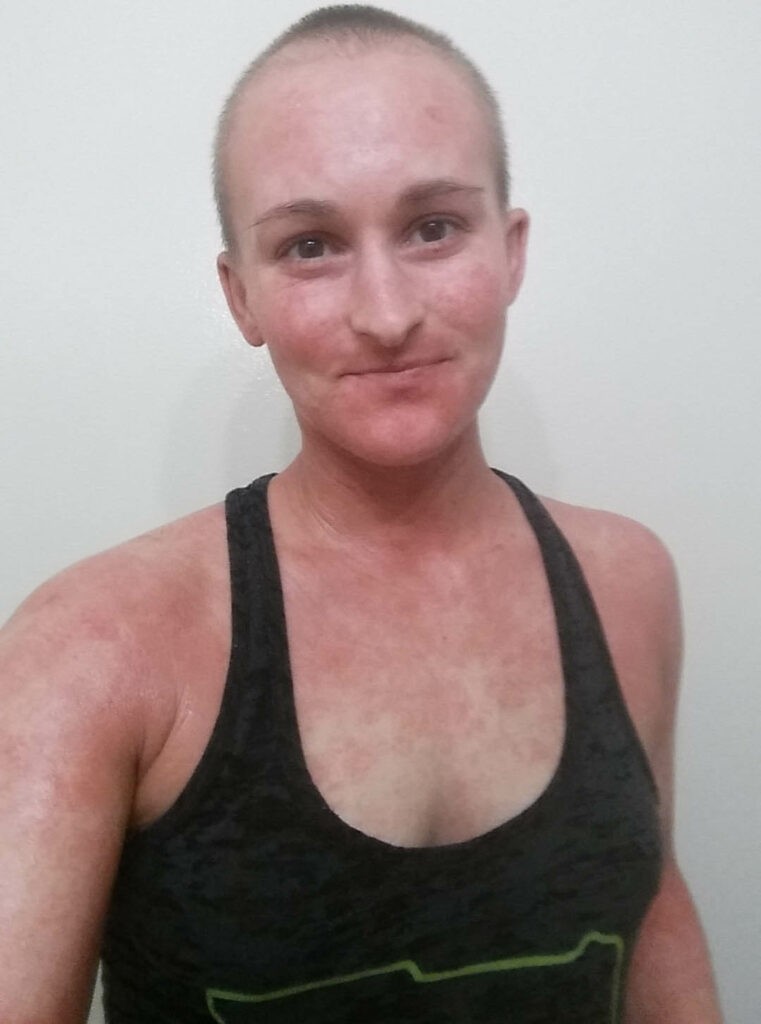Topical Steroid Withdrawal (TSW), also known as Topical Steroid Addiction or Red Skin Syndrome, is a condition that the eczema community and beyond needs to understand. While topical corticosteroids (TCS) are frequently prescribed to manage eczema and other skin conditions, it’s crucial to be aware of a potential, yet often unrecognized, side effect: TSW. This article delves into what TSW is, its symptoms, and how to navigate this challenging condition.
Linette Roungchun, who has experienced TSW intermittently throughout her adult life, vividly describes its impact: “The majority if not all of people with TSW end up homebound, having to completely upend their lives… TSW is not for the faint of heart.” Her words underscore the severity and life-altering nature of this condition.
The symptoms of TSW can be wide-ranging and debilitating, affecting many aspects of life. These withdrawal symptoms can include:
- Intense burning sensations on the skin
- Skin flaking, shedding, and peeling, which can spread beyond the treated area
- Swelling and dermatoses in areas previously treated with steroids
- Erythema, characterized by significant redness of the skin
- Thinning and wrinkling of the skin
- Oozing and pus-filled bumps
- Steroid dermatitis, leading to nodules and papules
- Persistent pain
- Insomnia and sleep disturbances
- Hair loss
- Uncontrollable shivering
- Chronic fatigue
- Depression and potential disability during prolonged withdrawal
Briana Banos, a long-term TSW sufferer and creator of the documentary “Preventable: Protecting Our Largest Organ,” emphasizes the far-reaching impact of TSW: “It touches every facet of your life… Emotionally, it is unbearably exhausting, and causes an avalanche of issues: loss of self, passion, partners and peace… It is an indefinite prison sentence and a type of suffering I wouldn’t even wish on an enemy.”
Olivia Hsu Friedman, DACM, who specializes in treating TSW patients, further highlights the severity, “This condition can degenerate to a place where a person is incredibly depressed, can’t function, can’t sleep and can’t hold onto a job. It can take them to a very dark place.”
While the most severe cases paint a stark picture, it’s important to note that TSW exists on a spectrum. Understanding what TSW is, how to recognize it, and how to manage it are crucial steps for those using topical steroids.
Defining Topical Steroid Withdrawal: What Does TSW Mean?
Topical corticosteroids (TCS) have been a cornerstone in eczema treatment for over half a century. These medications, including over-the-counter hydrocortisone creams, are effective, affordable, and widely used for reducing skin inflammation. They are prescribed for various types of eczema, such as atopic dermatitis and contact dermatitis, when basic skincare and moisturizers are insufficient.
However, the term “topical steroid withdrawal,” also known as topical steroid addiction, steroid withdrawal syndrome, or red skin syndrome, describes a cluster of symptoms that can arise when someone stops using topical corticosteroids, particularly after prolonged or potent use. It’s important to understand that TSW is not simply a return of the original skin condition; it’s a distinct reaction to the cessation of steroids.
Research into TSW is ongoing, and many aspects remain unclear, including the exact amount of steroid use that triggers TSW, how frequently it occurs, and who is most susceptible.
A systematic review published in the Journal of the American Academy of Dermatology, initiated by the National Eczema Association (NEA), shed some light on TSW:
- TSW appears to be more common in adult women and those who use mid- to high-potency TCS on the face or genital areas.
- Risk factors include prolonged daily use of topical steroids, application to sensitive skin areas, and abrupt cessation of TCS without tapering.
Dr. Eric Simpson, a dermatology professor at Oregon Health & Science University, emphasizes the reality of TSW: “TSW is real… It occurs most commonly in the setting of long-term and daily medium to high potency steroid use, especially on the face.” He advocates for better patient education on safe TCS use and improved recognition of TSW by dermatologists. Dr. Simpson suggests that intermittent use of topical steroids combined with non-steroidal therapies is key to preventing TSW.
Kathy Tullos, RN, president of ITSAN (International Topical Steroid Awareness Network), underscores the need for awareness within the eczema community. She points out the subtle and challenging nature of recognizing TSW: “There’s an invisible line between your ‘typical’ eczema and TSW.”
According to Tullos, warning signs of TSW include:
- Eczema symptoms spreading to previously unaffected areas.
- A shift in sensation from itching to burning or stinging.
- Changes in the skin’s appearance from a typical rash to a more sunburned or flushed look.
Tullos and her son experienced TSW firsthand, with her son suffering severe flaking across his body. Their recovery journey lasted 15 months. Studies indicate that TSW recovery can often extend beyond three months, and personal accounts frequently describe years of struggle. Dr. Lawrence Eichenfield suggests that newer biologic agents and systemic non-steroidal therapies might offer relief for TSW patients, highlighting the need for further research in this area.
How is TSW Diagnosed and Can it Be Prevented?
The exact mechanisms behind TSW are still being investigated. One theory, as mentioned in Practical Dermatology, proposes that TSW is a rebound effect from the sudden stop of TCS, leading to increased nitric oxide levels and excessive dilation of blood vessels in the skin.
Dr. Peter Lio, a member of the NEA Board of Directors and Clinical Advisory Committee, and co-author of the Practical Dermatology article, believes TSW is preventable with careful and judicious use of topical steroids.
Currently, there are no universally accepted diagnostic criteria for TSW. However, Dr. Lio identifies key indicators he looks for in his practice to differentiate TSW from severe eczema:
- Painful Skin Sensations: Burning, stinging, or pain that is more prominent than the typical itching associated with eczema.
- Diffuse Redness and Swelling: Confluent or widespread redness, often in a “red sleeve” pattern on limbs, accompanied by significant swelling, unlike the patchy redness of eczema.
- History of Potent Steroid Use: A history of significant and escalating use of medium to high potency topical steroids, or oral steroids, although this aspect can vary.
Dr. Lio emphasizes that “Awareness is key to understanding and preventing TSW.” He believes that widespread recognition and cautious topical steroid use can significantly reduce TSW cases, potentially making it a less common condition.
Briana Banos, through her documentary “Preventable,” aims to educate people and prevent others from experiencing TSW. She states, “Ninety-five percent of the TSW community is from the eczema community. We don’t want anyone else having to spill over. I hope to see true education about to how to prevent this from happening to patients.”
Individuals like Roungchun, Banos, and Tullos are actively building a strong TSW community through social media and collaborations with organizations like NEA, ITSAN, and others. Their efforts focus on raising awareness, providing support, and advocating for greater understanding and acceptance of TSW.
The Current Landscape of TSW Understanding and Support
Dr. Lio notes a significant increase in TSW discussions in recent years, partly due to resources like the “Preventable” documentary. He acknowledges that TSW definition and understanding are still in early stages. He advocates for reducing over-reliance on steroids and exploring non-steroidal options, ranging from systemic anti-inflammatory medications to natural botanicals and holistic approaches.
Kathy Tullos from ITSAN emphasizes that TSW recognition is still largely driven by patients. She points out continued skepticism within the medical community and the ongoing need for awareness campaigns. Tullos calls for greater acceptance of non-steroid management approaches and more support for patients seeking alternative treatments. Ideally, she envisions a future where healthcare providers proactively recognize TSW, rather than patients having to self-diagnose and educate their doctors.
What To Do If You Suspect TSW
If you believe you may have TSW, taking proactive steps is essential. Researching and seeking support are crucial first actions. ITSAN (itsan.org) is a valuable resource, offering medical articles, brochures for doctor appointments, videos, and a dedicated section for healthcare professionals. These resources can help you find practitioners knowledgeable about TSW and its management.
While discontinuing topical steroids is a common approach to allow healing, recovery timelines and symptom experiences vary greatly. Emerging evidence suggests that dupilumab, a medication, might be beneficial, but more research is needed to determine optimal TSW recovery strategies.
Dr. Lio advises starting with a trusted dermatologist but acknowledges that many practitioners may be unfamiliar with TSW due to its perceived rarity. He recommends contacting ITSAN or the National Eczema Association for referrals if needed.
For those unable to find local TSW-aware providers, virtual consultations are an option. Dr. Olivia Hsu Friedman offers virtual consultations and specializes in Chinese herbal medicine for dermatological conditions, suggesting that Chinese medicine can provide support for TSW. She emphasizes the importance of advocacy and collaboration with organizations like ITSAN and NEA to improve TSW awareness and patient care.
Hope for the Future of TSW Awareness and Treatment
When asked about their hopes for the future regarding TSW, experts and advocates offered these perspectives:
Linette Roungchun expresses hope in the data emerging from a comprehensive survey by ITSAN and the Allergy and Asthma Network, believing it will validate patient experiences and drive further understanding.
Kathy Tullos hopes that increased awareness, particularly through collaborations like ITSAN’s partnership with NEA, will lead to earlier recognition and prevention of TSW, ultimately resulting in better diagnosis and medical support for those affected.
Dr. Peter Lio anticipates that the development of new non-steroidal treatments will reduce reliance on steroids, potentially making TSW a condition of the past.
Briana Banos hopes for more doctors to become vocal advocates for the TSW community and for increased education on TSW prevention. She also emphasizes the need for effective, long-term safe treatments and greater consideration of holistic remedies.
To learn more about TSW, visit ITSAN.org and watch ‘Preventable.’ Discuss your eczema treatment plan and any TSW concerns with your healthcare provider to ensure you are making informed decisions about your skin health.

